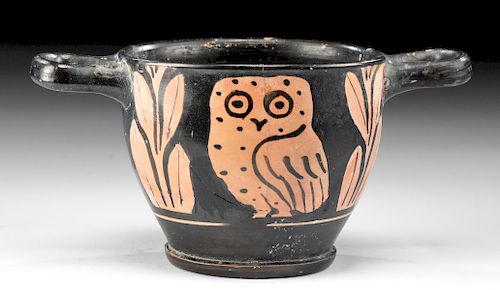Greek Apulian Red Figure Pottery Owl Skyphos
Lot 41b
About Seller
Artemis Fine Arts
686 S Taylor Ave, Ste 106
Louisville, CO 80027
United States
Selling antiquities, ancient and ethnographic art online since 1993, Artemis Gallery specializes in Classical Antiquities (Egyptian, Greek, Roman, Near Eastern), Asian, Pre-Columbian, African / Tribal / Oceanographic art. Our extensive inventory includes pottery, stone, metal, wood, glass and textil...Read more
Estimate:
$1,500 - $2,000
Absentee vs Live bid
Two ways to bid:
- Leave a max absentee bid and the platform will bid on your behalf up to your maximum bid during the live auction.
- Bid live during the auction and your bids will be submitted real-time to the auctioneer.
Bid Increments
| Price | Bid Increment |
|---|---|
| $0 | $25 |
| $300 | $50 |
| $1,000 | $100 |
| $2,000 | $250 |
| $5,000 | $500 |
| $10,000 | $1,000 |
| $20,000 | $2,500 |
| $50,000 | $5,000 |
| $100,000 | $10,000 |
| $200,000 | $20,000 |
About Auction
By Artemis Fine Arts
Sep 26, 2019
Set Reminder
2019-09-26 10:00:00
2019-09-26 10:00:00
America/New_York
Bidsquare
Bidsquare : Exceptional Day 1: Antiquities & Asian Art
https://www.bidsquare.com/auctions/artemis-gallery/exceptional-day-1-antiquities-asian-art-4437
Day 1 of an important 2-day auction featuring exceptional, museum-worthy examples of Egyptian, Greek, Etruscan, Roman, Viking, Russian, Near Eastern, as well as Asian Art from China, Japan, Thailand, Vietnam, Burma and India. Artemis Fine Arts info@artemisfinearts.com
Day 1 of an important 2-day auction featuring exceptional, museum-worthy examples of Egyptian, Greek, Etruscan, Roman, Viking, Russian, Near Eastern, as well as Asian Art from China, Japan, Thailand, Vietnam, Burma and India. Artemis Fine Arts info@artemisfinearts.com
- Lot Description
Magna Graecia, South Italic Colonies, Apulia, ca. 340 to 325 BCE. A wheel-thrown pottery skyphos of a classic Attic form with a squat foot, a tall body with gradually expanding walls, a thin rim, and a pair of applied loop handles. Each side of the black-glazed vessel features a charming red-figure owl, standing upon petite feet and holding a feathery wing against the breast, the head with wide eyes and a slender aquiline beak, and framed between a pair of leafy olive branches. This type of skyphos was extremely popular for several centuries, initially exported from Athens throughout the Greek world, including into Italy and its surrounding isles. Size: 5.9" W x 2.9" H (15 cm x 7.4 cm).
The owl is a symbol of Athena and is often shown accompanying her; Athena was the goddess of the city of Athens, and so the owl became a symbol of Athens and its government. The olive tree, as well, relates to Athens. Athena and Poseidon were said to have quarreled over the city of Athens and Athena planted an olive tree on the Acropolis to show that it belonged to her. Herodotus records that, although the Persians burnt all the Acropolis, the remains of the olive tree sprouted a new branch the very next day. The Athenian imagery present on this piece reminds us of the power of Greek cultural symbols in the ancient world.
Provenance: private J.H. collection, Beaverton, Oregon, USA
All items legal to buy/sell under U.S. Statute covering cultural patrimony Code 2600, CHAPTER 14, and are guaranteed to be as described or your money back.
A Certificate of Authenticity will accompany all winning bids.
We ship worldwide and handle all shipping in-house for your convenience.
#149643Repaired from multiple large pieces, with light in-fill material, resurfacing, and overpainting along break lines. Minor abrasions and nicks to handles, rim, body, and base, with light fading to original glaze pigmentation. Original owl iconography is still visible and clear.Condition
- Shipping Info
-
All shipping is handled in-house for your convenience. Your invoice from Artemis Gallery will include shipping calculation instructions. If in doubt, please inquire BEFORE bidding for estimated shipping costs for individual items.
-
- Buyer's Premium



 EUR
EUR CAD
CAD AUD
AUD GBP
GBP MXN
MXN HKD
HKD CNY
CNY MYR
MYR SEK
SEK SGD
SGD CHF
CHF THB
THB
















